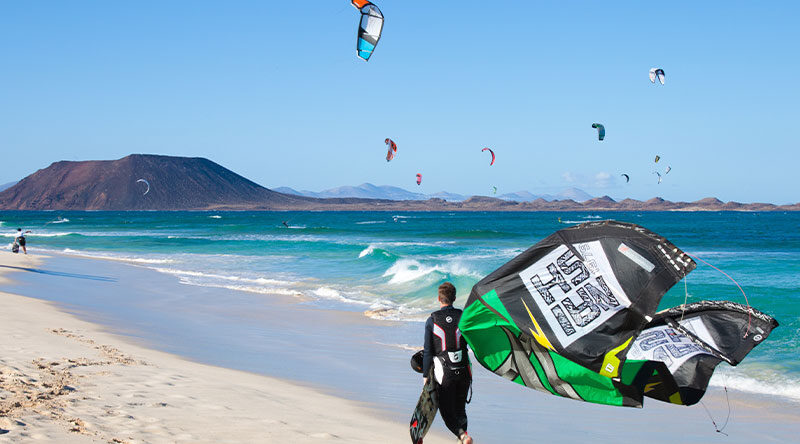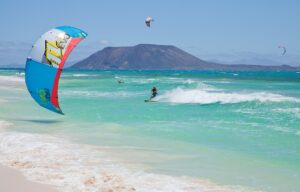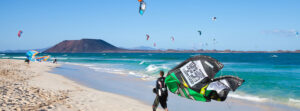
Fuerteventura
A practical guide to kitesurfing in Fuerteventura
Fuerteventura is one of the Canary Islands and is located in the Atlantic Ocean near North Africa. It is one of the best spots in Europe with an average temperature of more than 20 degrees throughout the year and the best windy months are with the trade winds from May to August.
Fuerteventura is home to beautiful beaches, incredible dunes, a volcanic landscape worthy of admiration and it also has the perfect weather to practise any water sport, almost all year round. Thanks to its wind and its beaches, this island is considered one of the meccas for sports such as Windsurfing or Kitesurfing.
The practice of kitesurfing is mainly concentrated around the Grandes Playas, a series of beaches that accompany the Natural Park of the Dunes of Corralejo. The best known is the Old Man beach, commonly called “Flagbeach” among kiters. A spot for all levels of kitesurfing The “Flagbeach” beach is famous for its rocks and is not recommended for those who are at the beginner level. It is recommended to know how to girdle well to be able to navigate there since if you do not run the risk of having to go out on the rocks. It is important that those who have never sailed there, go only at high tide, that is, the safest thing is to navigate from an hour and a half before to an hour and a half after the maximum tide point.
The winds to kitesurf in Fuerteventura
North Wind (Alisios): It is the prevailing wind in late spring and during summer. It is a somewhat land wind but very constant. When the tide conditions are good (medium-high) and there is not much swell, the spot is perfect for freestylers. When there is swell, it is a perfect place to learn to surf, especially at the end of the beach, where an excellent left breaks (although on top of the rocks).
North East Wind: This wind comes from Lanzarote, and due to the Isla de Lobos it is very gusty wind. When it comes in strong, you can kite on Flag beach, but they are not the best conditions for this spot. Also, this wind makes the sea very choppy and with waves, which make it very uncomfortable to navigate. Another place where you can go when this wind comes in is Cotillo beach.
-Southeast wind: The SE wind enters side-onshore, which brings wind waves and a lot of choppy. It is like the NE but entering from the other side. It is not a usual wind, but some winter conditions are given to kite with SE.

The 9 best Kitesurfing spots in Fuerteventura
If you are a lover of extreme sports and adventures, surely you practice Kitesurfing. As a good connoisseur of your hobby, you should also know which are the best places to do it without a problem. Fuerteventura, in the Canary Islands, represents a great proposal for kitesurfing. It is a perfect destination, especially in the summer holidays, since most of the year it has a pleasant climate. When the wind is not blowing strongly, you can also enjoy the waves and surf.
The strong wind that develops thanks to the waves of the sea facilitates the handling of the kite, which results in a tremendous trip. Here we introduce you a list of the top spots to kitesurf in Fuerteventura. We hope you like it 🙂
1.Flag Beach
Near Corralejo, we find this great beach. It is the main beach for kitesurfing in Fuerteventura. There are kite clubs on the beach, rescue services, supplies, rentals, and lessons. The sea is deep, and it is mainly due to the reefs, so you have to be careful at low tide.
2- El Cotillo
El Cotillo is a beautiful beach surrounded by a cliff. The wind is good when you are heading north or northwest. However, it can get strong (over 20 knots) on some occasions.
The beach is divided into three areas: one for surfing, one for kitesurfing and the last one for windsurfing. This spot is not for beginners.
3. Sotavento
Towards the southeast of Fuerteventura, there is a beautiful Sotavento beach. In it, you will find a kitesurf spot suitable for all levels, thanks to the great extension of the beach and the force of the wind that hardly diminishes in intensity throughout the year.
Sotavento has been chosen on numerous occasions to celebrate the Kitesurfing World Championship in Fuerteventura and, during the dates this event takes place, this beach brings together the most important figures in this sport, as well as hundreds of fans.
If what you are looking for is a lagoon, but with a strong wind, Sotavento is ideal. A large tide forms in the area, and the beach is open to the sea. The wind direction is mainly lateral, so the sea is not recommended for beginners.
The lagoon is shallow, but the wind comes from all directions. The wind is blowing, at about 20 – 30 knots. The lagoon tends to fill on the new and full moon, and this only happens 2-3 weeks a month. The best time to practice is when the tide is high, that is, between noon and sunset.
Sotavento It is actually where there is more wind on the island of Fuerteventura. It is a long sandy beach that does not get crowded or 200 kiters because it is so large. With offshore wind, the watchtowers and rescue boats guarantee the safety, and they will always rescue you when you are in trouble. You have to take into account that you pay for this service, ask when you arrive at René Egli Fuerteventura Windsurf Center.
They also have a school and rental of kitesurfing and windsurfing equipment. The windsurfing and kitesurfing areas are extensive and small lagoon forms that fill up at high tide to create a perfect area of shallow, flat water ideal for learning to kite or improving your tricks. The offshore wind is quite gusty, especially in summer that can reach up to 40 knots.
4. Majanicho
This beautiful place has a difficult entrance due to the sharp rocks. Sometimes the water is calm and sometimes rough in the inner bay. However, it does have good waves on the outer reef. Not for beginners, and booties are recommended because of the number of sharp rocks.
5. Burro Beach
If you are just starting in this sport, there is an area in Burro Beach reserved for beginners with soft and short waves, where you can learn safely. As for expert or intermediate kiters, they can have a great time dodging waves of different sizes and dealing with the high-intensity trade winds, especially in the summer seasons.
6. Cala de Fuste
Near the Sotavento beach is Cala de Fuste, which is a protected area from strong currents and waves of the sea. In case you have never practised kitesurfing in Fuerteventura, within this spot you can get started with this sport.
7. Cofete
Cofete is one of the most isolated spots for kitesurfing in Fuerteventura. Also, it has a huge confluence of currents, since the North Sea meets the South Sea, giving rise to large waves.
8. Matas Blancas
Matas Blancas is an excellent spot for kiteboarding for those who want to kite the open sea safely. There are different types of winds; however, the weak force of the waves make it suitable for all levels.
9. Puerto Lajas
Finally, there is Puerto Lajas, a spot located east of Fuerteventura to practice kitesurfing among the waves. The winds of this place come from the northeast and, sometimes, it is possible to share space with surfers and windsurfers, other trendy water sports on the island.

Conclusion
Compared to other islands, Fuerteventura has a large number of beaches to practice freely, as well as reefs. The most experienced kitesurfers will be able to put their kites on the beach and the sand.
Between May and June, the amount of sand is reduced due to the winter swell. While in July and August, the beaches have more sand.
The south of the island has a characteristic that makes the wind statistics rise significantly. In the area of Jandía, the wind is encased between the mountains and comes from the ground a little lateral and very reinforced. That makes the spots in the southeast, and specifically Sotavento and its surroundings, a safe place to find wind when the rest of the island is not enough to plan.
In the south of the island, the kiteboarding conditions are more for freeride. Strong wind in summer and medium in winter and some waves to start, so a versatile material for strong wind is the most suitable. The water temperature makes the short suit advisable in summer and long in winter.